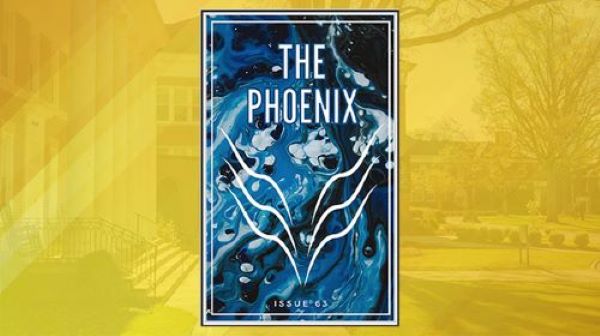
A Student-led Publication with Staying Power
Emily Ruppe ’24, a junior at Pfeiffer University, has always viewed writing as a serious hobby. Beginning in early childhood and throughout her high school years, she filled spiral notebooks and Google docs with writings on all manner of subjects. Yet because she never aspired to write for a living, she didn’t consider pursuing ways to publish her pieces.
“I assumed my writing would stay trapped where nobody could read it,” said Ruppe, who is double-majoring in Psychology and in Counseling and Human Services. “When students think of writing, they often think, ‘Oh, I have a history essay or a lab report to write up.’ There are not too many places to express your creativity and things that make you vulnerable.”
Ruppe’s view of the literary universe and her role in it has changed dramatically, thanks to The Phoenix — Pfeiffer’s literary journal — which has featured two of her pieces, each an example of creative nonfiction. In Ode to Laika, which ran during Ruppe’s sophomore year, she illuminates her take on the dog who died aboard Sputnik 2 in 1958.
Graveyards, published when Ruppe was a freshman, proposes that the grave of her late mother “is just a piece of stone” and that “her spirit is with me all the time.” Ruppe said that writing Graveyards helped her “come to terms with not feeling obligated to visit my mother’s grave and put flowers down and follow all the social cues.”
The Phoenix, a print publication that comes out once a year each spring, includes fiction, poetry, creative nonfiction, artwork, and photography. Founded in 1958, it is the principal creation of the longest-running student-led organization at Pfeiffer. That it provides Ruppe and many other students (and non-Pfeiffer contributors from as far away as Ireland and India) with an outlet for their non-academic work certainly helps explain why it’s been going strong for 64 years. But many other factors account for the publication’s staying power.
Dr. Edward Royston, an Assistant Professor of English at Pfeiffer, serves as the faculty advisor for The Phoenix. His students and others continually gravitate to the publication because it is something over which “they can take full ownership,” he said. Student staffers make all editorial decisions, from determining the content of The Phoenix after considering blind submissions to shaping how the magazine’s cover and layout will look.
“At the end of a year working on it, the students have created a tangible product that they can put in their hands and show off to family members and friends,” he said. “Especially in our day and age, when it’s fashionable to question the utility of studying or majoring in English, the ability to create an actual object that you can give to people to flip through really gives the students a sense of pride and a sense of meaning to their accomplishments.”
Putting together a magazine requires a lot of know-how — so much, in fact, that the staff of The Phoenix learns it not as part of an extracurricular activity but during a for-credit course that meets three hours each week. The course covers many technical skills, including how to use Submittable.com to manage submissions and how to use Wix.com to manage the publication’s website. Students also master software programs such as Canvas, which is used to create posters and other promotional materials, and InDesign, which is used to create the magazine itself.
Louisa Parrish ’23, the Editor-in-Chief of The Phoenix, wants to land a job in publishing after she graduates next spring, and she recently made her debut as a novelist (see related story in this edition of The Falcon Connection). In addition to having mastered the nuts and bolts of publishing a magazine, she’s developed in many other ways that will benefit her in the workplace: “I’ve learned how to get projects done on time, and I now know how to work successfully with other people, how to navigate when an issue comes up, and how to promote things.”
Each student who takes the Phoenix course is required to take on what Royston described as “some kind of project that will help promote or grow or build out the journal in some way.”
The projects run the gamut. Recently, for example, several new sections have been added to what the Phoenix’s website offers, each designed to appeal to different interests. In a section called “The Music Note,” there’s an appreciation of David Bowie’s music that includes a Spotify selection of his work. There are also reviews of coffee (in “The Coffee Bean with Hannah Dean”); reviews of upscale dining establishments by Alayna Eure (“Alayna Eats”); and a section that considers the artistic side of athletes (“Art of Athletes”).
The Phoenix is also bullish on having students organize and present such events as writers’ workshops, launch parties and play readings. Cortney Queen ’23, who has published her poetry in The Phoenix, now serves as one of the publication’s editors. She has organized and participated in several Phoenix-sponsored poetry slams on Pfeiffer’s Misenheimer campus.
“It’s amazing how many things our organization does,” she said. “I’m so glad I became a member of it.”